
Agro Diesel (India) Private Ltd
Add a reviewOverview
-
Sectors Administrative Support
-
Posted Jobs 0
-
Viewed 21
Company Description
Pests Of Jatropha
Jatropha Curcas is getting importance commercially as the demand of fossil fuels increases greatly and likewise Jatropha is an eco-friendly energy plantation. Plantation of this plant is thought about to be an outstanding fuel alternative and it is also really economical compared to other fuels. Recently, Jatropha is dealing with some difficulty with pests and illness. The insects are classified into two varieties: Pest that affect young plants and Pest that affect grown plants.
Young plant pests: Cutworm, Scarabeid Beetle, Army worm, Grasshopper.

Agrotis ipsilon: It is commonly known as Cut worm. This bug affects the seedlings and young Jatropha plants. If the plant is affected by the cutworm, the stem gets cut nearer to the soil surface and this will diminished the plant entirely.
Control: This pest can be controlled by selecting the larva discovered around the plants or by mixing the bran, sawdust with insecticides.
Scarabaeid Beetle: This bug destroys the root of the young plant. Initially, the larva consumes the natural matters present in the soil and then comes to the root. The larva attack may eliminate the entire plant.
Control: The plant with great resistance power can overcome the insect. For heavy attack, insecticides with parts carbosulfan and carbofuran can be used to eliminate the pest.
Army worm: Spodoptera litura existence can be recognized by biting in the leaves. The severe infection could totally kill the plants.
Control: Insecticides are used to manage the insects.
Grasshopper: This prevails pest found in numerous plants. Valanga nigricornis and Locusta migratoria extensively assaults the plant. The pest typically assaults the young plant.
Control: The insecticides utilized betacyfluthrin, cypermethrin, thiodicarb, MIPC, and fipronil.
Pest observed in fully grown plants:
Pest of Stem: Ostrinia furnacalis, Xyleborus spp.
Ostrinia furnacalis and Xyleborus: This pest harms the Jatropha stem and it is widely seen in Indonesia. The stem attacked by this insect usually fall down. The presence can be identified by the larva penetration hole at the stem.
Control: The Insecticide normally used to control this pest is carbofuran.
Pest of leaf: The typical pests observed are leaf caterpillar, Neetle caterpillar, Leaf hopper, Mite, Ear corn caterpillar.
Leaf Caterpillar: This pest can consume all the leaves of the plant in short duration. The quality and yield of the seeds get reduced due to the heavy attack.
Control: This can be controlled by choosing the old larvae around the surface area and discarding the attacked leaves.
Needle Caterpillar: This caterpillar is covered with spines and produces a burning experience when enabled to contact with skin as it produces particular chemical substance. Initially the insect crowded in the leaf and then spread all over the plant when it grows older.
Control: Manually, the insect can be killed only by soaking it in water or kerosene. The heavy attack can be managed by spraying organophosphate insecticides.
Leaf Hopper: This bug is found mainly in tropical and subtropical areas. The pest targets the leaf and draws all the nutrients of the leaf and gets curls at the idea. Later, the entire leaf dry and die.
Control: The heavy attack can be controlled by utilizing insecticides like imidachloprid, beta cyfluthrin or carbosulfan.
Mite: Mite likewise attacks the leaf and makes the whole plant weak. The bug presence can be recognized when the leaf ended up being yellowish, diminishes, reddens and fall down. The insect can also be spread out through fallen leaves.
Control: Some preventive procedures can be done like correct sanitation and burning the fallen leaves. Heavy attack can be dealt with by spraying insecticides.
Some dreadful bug which attacks flower and fruit are, Stink bug (Nezara viridula)
Chrysocoris javanus, Tip borer caterpillar.
Stink Bug: Sting bug is a severe bug which attacks the plant during blossom duration so the crop yield totally drops. This insect is seen around the tropical region.
The hazardous enzyme in the plant shrinks the whole plant.
Control: Insecticides recommended for this pest is chlorfluazuron, diflubenzuron, alfamethrin, and lamda cyhalothrin.
Tip borer caterpillar: The insects typically happens attacks the plant in flowering season and this pest is seen in tropical areas. The female insect laid the eggs on the tender part of the plant and the young larvae feed the young fruits and plant ideas.
Control: Manually, the assaulted seeds are recommended to burn. The insecticides like monocrotophos and bensultap are sprayed at the blooming season.

